
Salisbury Cathedral, formally the Cathedral Church of the Blessed Virgin Mary, is an Anglican cathedral in Salisbury, England. The cathedral is the mother church of the Diocese of Salisbury and is the seat of the Bishop of Salisbury.

St Botolph's Church is the Anglican parish church of Boston, Lincolnshire, England. It has been referred to as "Boston Stump" since it was constructed. Its tower is 266 feet 9 inches (81.31 m) tall, and was long used as a landmark for the Boston fishermen; on a clear day it can be seen from Norfolk. The church is a grade I listed building.

Chesterfield is a market town in the Borough of Chesterfield, Derbyshire, England. It is 24 miles (39 km) north of Derby and 11 miles (18 km) south of Sheffield at the confluence of the River Rother and River Hipper. In 2011, the built-up-area subdivision had a population of 88,483, making it the second-largest settlement in Derbyshire, after Derby. The wider borough had a population of 103,801 in 2011. In 2011, the town had a population of 76,753.

The Church of St Mary the Virgin, widely known as St Mary Redcliffe, is the main Church of England parish church for the Redcliffe district of the city of Bristol, England. The first reference to a church on the site appears in 1158, with the present building dating from 1185 to 1872. The church is considered one of the country's finest and largest parish churches as well as an outstanding example of English Gothic architecture. The church is so large it is sometimes mistaken for Bristol Cathedral by tourists. The building has Grade I listed status, the highest possible category, by Historic England.

A spire is a tall, slender, pointed structure on top of a roof of a building or tower, especially at the summit of church steeples. A spire may have a square, circular, or polygonal plan, with a roughly conical or pyramidal shape. Spires are typically made of stonework or brickwork, or else of timber structures with metal cladding, ceramic tiling, roof shingles, or slates on the exterior.
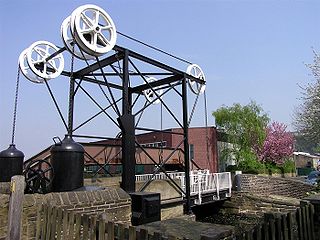
The windlass is an apparatus for moving heavy weights. Typically, a windlass consists of a horizontal cylinder (barrel), which is rotated by the turn of a crank or belt. A winch is affixed to one or both ends, and a cable or rope is wound around the winch, pulling a weight attached to the opposite end. The Greek scientist Archimedes was the inventor of the windlass. The oldest depiction of a windlass for raising water can be found in the Book of Agriculture published in 1313 by the Chinese official Wang Zhen of the Yuan Dynasty.

A tented roof is a type of polygonal hipped roof with steeply pitched slopes rising to a peak. Tented roofs, a hallmark of medieval religious architecture, were widely used to cover churches with steep, conical roof structures.
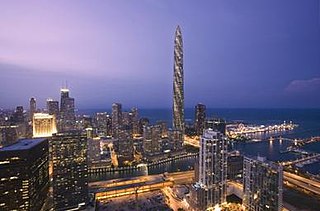
The Chicago Spire was a skyscraper project in Chicago that was partially built between 2007 and 2008 before being cancelled. Located at 400 N. Lake Shore Drive, it would have stood 2,000 feet (610 m) high with 150 floors and been the tallest building in the Western Hemisphere. When originally proposed as the Fordham Spire in July 2005, the design had 116 stories, included a hotel and condominiums, and was topped with a broadcast antenna mast. The building was designed and spearheaded by Spanish architect-engineer Santiago Calatrava and Chicago developer Christopher T. Carley of the Fordham Company. On March 16, 2006, the Chicago Plan Commission unanimously approved the initial design of the building. On November 4, 2016, a court ruling brought the original development plan and the extended litigation over the nine-year-old project to a close. Developer Garrett Kelleher signed over the property location to the project's biggest creditor, Related Midwest, who announced that they would not build the Spire and released plans for a different project.

The Frauenkirche is a church in Munich, Bavaria, Germany, that serves as the cathedral of the Archdiocese of Munich and Freising and seat of its Archbishop. It is a landmark and is considered a symbol of the Bavarian capital city. Although called "Münchner Dom" on its website and URL, the church is referred to as "Frauenkirche" by locals.

Long Sutton is a market town in the South Holland district of Lincolnshire, England. It lies in The Fens, close to the Wash, 13 miles (21 km) east of Spalding.

The Church of Our Saviour is a baroque church in Copenhagen, Denmark, most famous for the external spiral winding staircase that can be climbed to the top, offering extensive views over central Copenhagen. It is also noted for its carillon, which plays melodies every hour from 8 am to midnight.

The Parish Church of St Mary the Virgin is located at the highest point in the town centre of Bury, Greater Manchester, England. The church is located on the edge of the town centre, and is just a few minutes walk from the town's bus and tram station, as well as the Millgate Shopping Centre and the newly built the Rock. The main body of the church was completed on the 2 February 1876, the steeple predates it to 1842. It is recorded in the National Heritage List for England as a designated Grade I listed building.
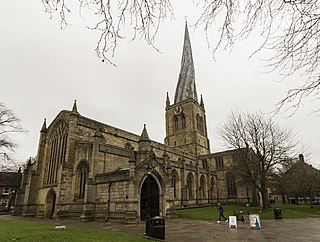
Chesterfield Parish Church is an Anglican church dedicated to Saint Mary and All Saints, in Chesterfield, Derbyshire, England. Building of the church began in 1234 AD, though the present church dates predominantly from the 14th century. Designated a Grade I listed building in 1971, St Mary's is best known for its twisted and leaning spire. It is the largest parish church in the Diocese of Derby and forms part of the Archdeaconry of Chesterfield. In 1994, it also became the UK's only representative in the Association of the Twisted Spires of Europe; of the 72 member churches, it is deemed to have the greatest lean and twist.
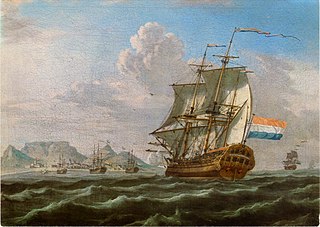
A landmark is a recognizable natural or artificial feature used for navigation, a feature that stands out from its near environment and is often visible from long distances.

Capital Gate, also known as the Leaning Tower of Abu Dhabi, is a skyscraper in Abu Dhabi that is over 160 meters (520 ft) tall, 35 stories high, with over 16,000 square meters (170,000 sq ft) of usable office space. Capital Gate is one of the tallest buildings in the city and was designed to incline 18° west, more than four times the lean of the Leaning Tower of Pisa. The building is owned and was developed by the Abu Dhabi National Exhibitions Company. The tower is the focal point of Capital Centre.

A hip roof, hip-roof or hipped roof, is a type of roof where all sides slope downwards to the walls, usually with a fairly gentle slope. Thus, a hipped roof has no gables or other vertical sides to the roof.
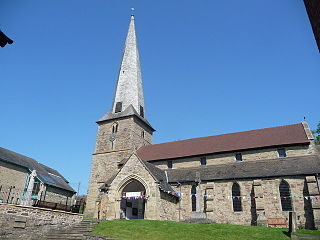
St Mary's Church is on Church Street, Cleobury Mortimer, Shropshire, England. It is an active Anglican parish church in the deanery of Ludlow, the archdeaconry of Ludlow, and the diocese of Hereford. Its benefice is united with those of six local parishes to form the Cleobury Benefice. The church is recorded in the National Heritage List for England as a designated Grade I listed building. It is notable for its shingled twisted spire.


















